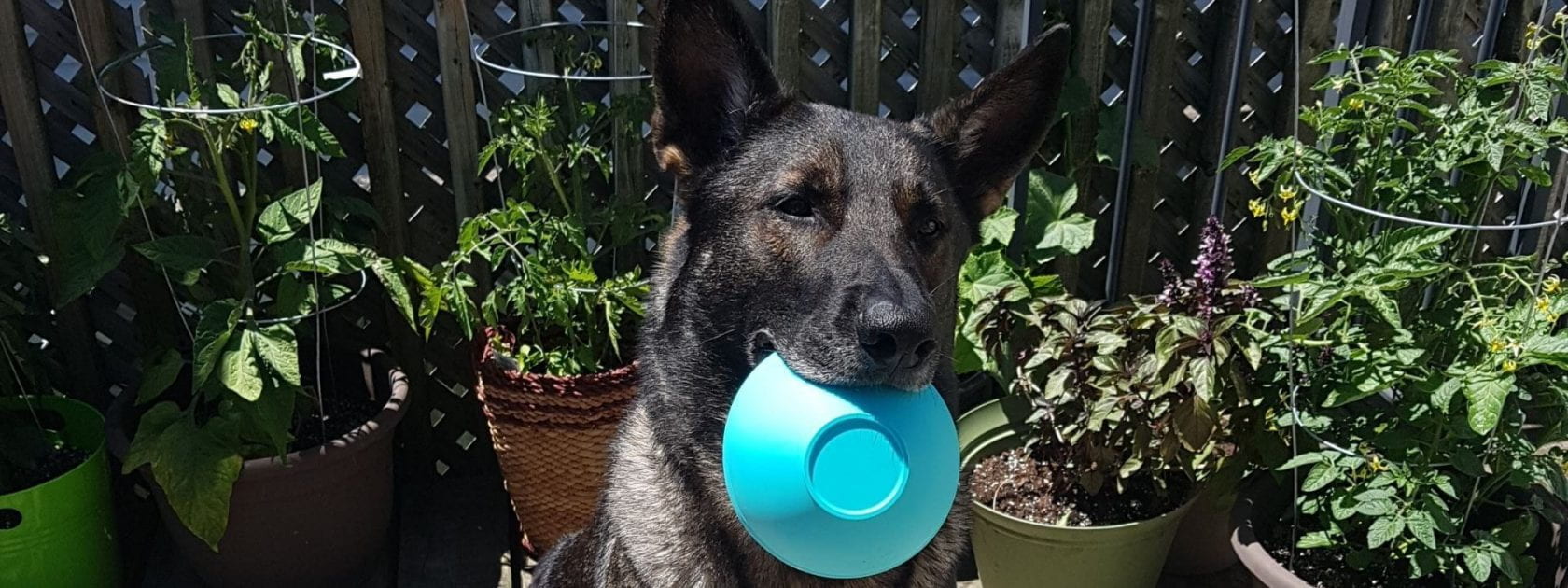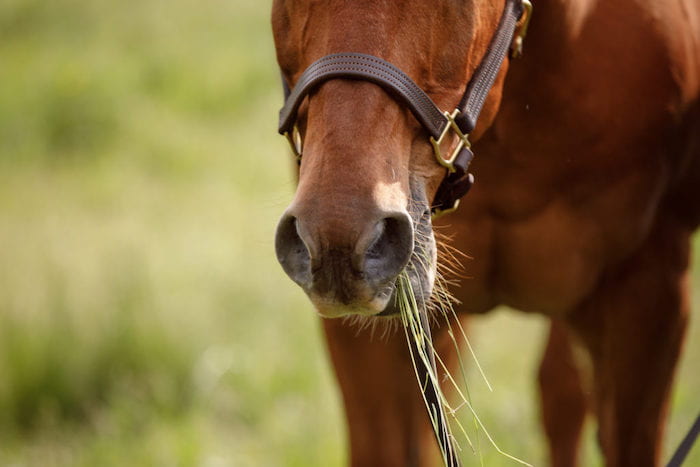Believe it or not, but springtime is coming soon! With the arrival of spring, comes warmer weather, fresh new grass growth, shedding season and more time in the saddle for horse enthusiasts. To help your horse transition from the frigid Canadian winter to spring, this blog post will provide you with some helpful tips.
Before we discuss why horses need a gradual introduction to springtime grazing—it is important to have a good understanding of how to assess your horse’s weight and body condition.
Watching your horse’s weight
Monitoring your horse’s weight over winter is an important step in their nutrition. Some horses will lose weight over winter and others will gain weight after a season in-front of a round bale. Before making any changes to your horse’s diet this spring, it is important to determine their current weight and body condition score.
The best option for determining your horse’s weight is by using a large scale which is often found at your large animal veterinarian’s clinic. You can also utilize a weight tape. Though this method is not as accurate as a scale, it will allow you to track relative body weight changes over time, giving you a good idea of how their diet is meeting their needs. Another option is to calculate your horse’s weight using a formula. Simply take their heart girth*x heart girth x body length* and divide this number by 330.
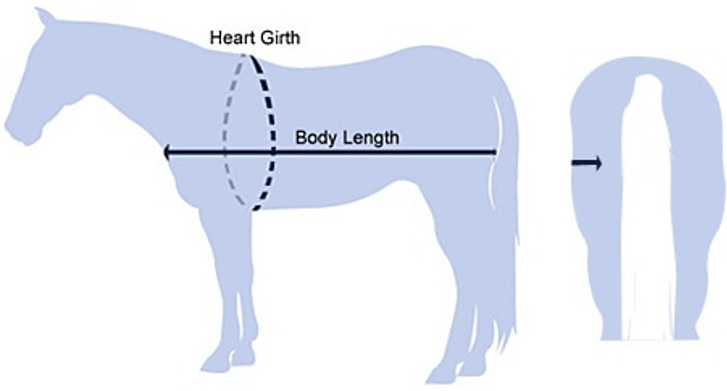
Body Condition Score (BCS)
Aside from keeping an eye on your horse’s weight, another important quantitative tool is body condition scoring (BCS). Similar to how we score dogs and cats, BCS is a method which estimates your horse’s adipose tissue (fat) in various anatomical locations thereby assessing whether they are over, under, or ideal weight. The Henneke Body Condition Scoring System uses a scale of 1 to 9, where each number represents the amount of adipose (fat) stores the horse has on their body. Developed by Dr. Don Henneke at Texas A&M University, the system scores 6 areas on the horse: the crest on the neck, behind the shoulder, the withers, across the rib cage, over the back in the loin area and the top of the tail. A score of 1 is poor and a 9 is extremely obese. The ideal range for most horses is 4 to 6, whereas performance horses should be closer to a 4 or 5.

Having an understanding of your horse’s body fat percentage then can allow you to match their diet’s caloric intake to their body condition. For horses on the slimmer side of a BCS, this would mean providing more calories, yet for the overweight BCS, it would mean a reduction in calories. Learn more about the Henneke Body Condition Scoring system, here.
Weight tracking, body condition scoring and photographing your horse are all steps that should be done regularly to track your horse’s condition and response to their nutrition.
The importance of spring transition
Sudden changes to a horse’s diet can cause great upset for their digestive tract. The cecum and colon, more commonly referred to as the hind gut, is the site of fibre fermentation in the horse and is home to a unique population of microbes which are specialized to your horse’s diet. Abrupt changes to a horse’s diet will not give the microbial population enough time to adjust, and this can lead to upset such as diarrhea or even, life threatening colic.
Before we jump into how we should gradually introduce a horse to springtime pasture, first we must understand the nutritional needs of the horse.

Forage’s contribution to your horse’s diet
Forage, which is in the form of hay or pasture, is the key to a horse’s diet. Forage not only provides your horse’s needed vitamins, minerals and protein, but it also plays an important role in keeping their digestive system in optimal health. Of course, not all forage sources are created equally, and each will vary based on plant variety, geographic, soil and management practices. This is why nutrient testing of all forages that your horse consumes to ensure they are receiving their nutrient requirements is highly recommended. Not sure of your horse’s nutrient requirements? The National Research Council (NRC, 2007), has created guidelines for what nutrients various horses require at different work levels. Additionally, a quick Google search will return laboratories in your area that will be able to provide forage testing. Both these resources will allow you to better meet the nutritional needs of your horse.
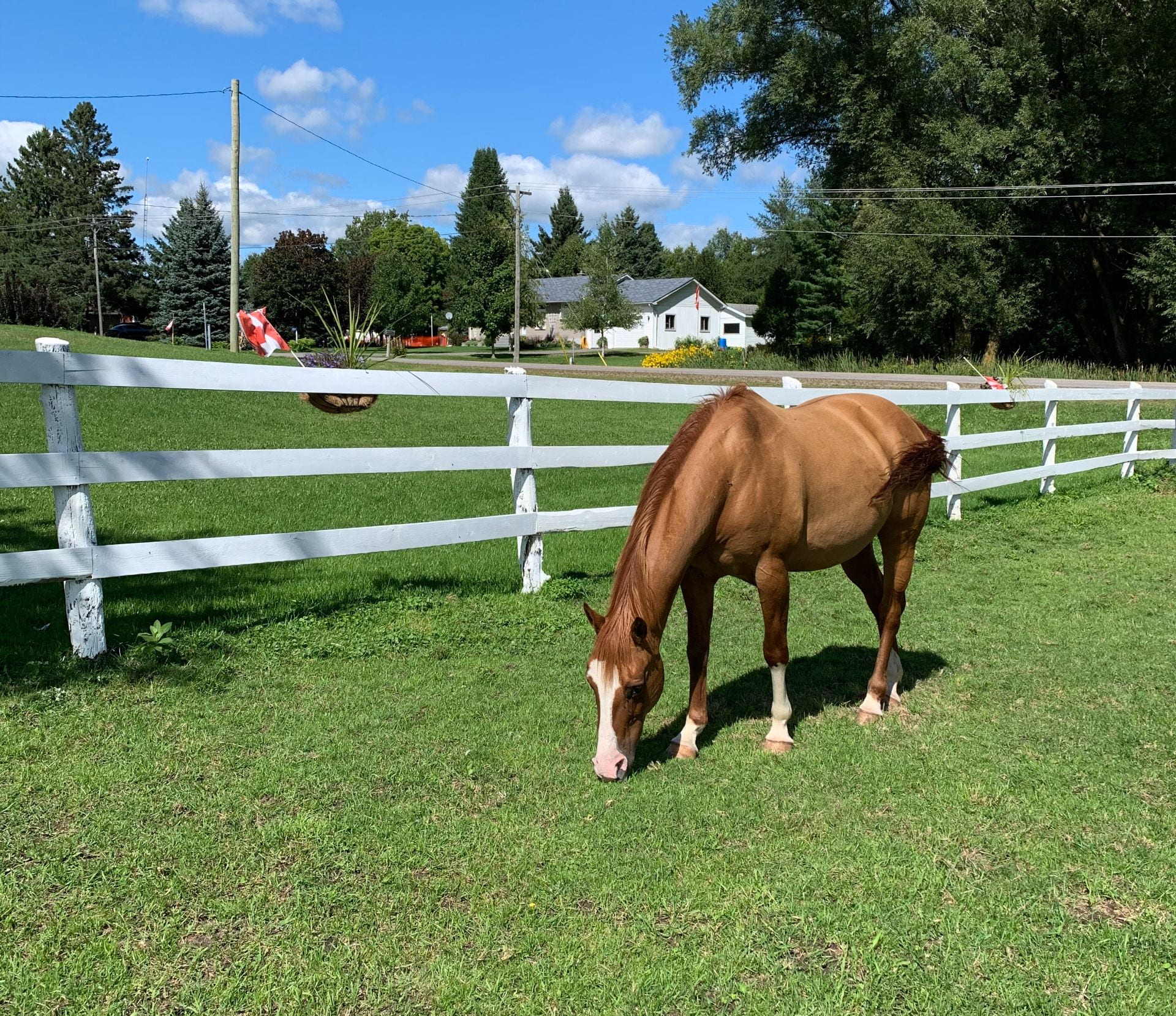
Transitioning your horse from a hay to grass diet this spring: 4 key steps!
The arrival of spring in only a short few months means a transition to fresh forage is soon to begin for your horse. Before simply placing your horse out to pasture, follow some of these tips:
1. Evaluate current diet
Before spring arrives, take some time to evaluate your horse’s weight, body condition and current diet, as mentioned above. Lush, more nutrient dense pasture might mean that you can now reduce dietary supplements such as oils, vitamins or minerals while your horse is turned out in pasture during the warmer months. Additionally, any higher calorie grains that you have been feeding over the winter should be evaluated again once your horse is consuming a fresh forage source to determine if they are needed in the same amounts. Just as it is recommended to test your hay, it is also recommended to nutrient test your grass and soil. Without testing, it can be hard to know what nutrients your horse is consuming and in what amounts.
2.Evaluate current health condition
Spring grass tends to be higher in nutrient composition when compared to other seasons. New spring growth will have high non-structural carbohydrates (NSC), including sugars, starches, and fructans. For horses that are more sensitive to high sugar and starch content, a very careful transition to grass is required to reduce the risk of founder, laminitis and metabolic dysfunction. Horses that are obese, already suffering from Cushing’s Disease (PPID – Pituitary Pars Intermedia dysfunction), insulin resistance or laminitis all fall under the category of being “more sensitive horses” and will require a very structured approach to grazing.
Just because your horse is not obese or suffering from a nutritionally related disease, doesn’t mean they should be let free on springtime grass without caution. Just like sensitive horses, a structured approach is recommended.
3.Letting horses out on pasture
Before allowing your horse to graze on spring pasture, the first step is ensuring there is adequate grass growth. The best option is to wait until your pastures are at least 6 inches in length before allowing grazing. The perennial grasses often found in horse pastures in Ontario store their energy for growth in these first few inches of the plant. By allowing your horse to graze before the plant is long enough, not only will your horse have access to a much higher sugar content, but they will also deplete the energy stores of the plant which is needed for its own growth. Another common mistake most horse owners or stables make is that they stop feeding hay too soon. It may appear that your pastures are ready to support grazing and that lots of grass is available, however, early spring grass is higher in water content, but low in fibre content. If you remove all hay sources, spring pasture might not meet the dry matter intake needs of your horse on its own and this could lead to unintentional weight loss. Thus, allowing for some mature pasture growth and continuing to include some hay is important at the beginning of the grazing season.
4.Introducing your horse to pasture slowly this spring
This spring take the gradual grazing approach. After the minimum grass length has been reached, SLOWLY introduce your horse to spring pasture.
SUGGESTED GRAZING SCHEDULE
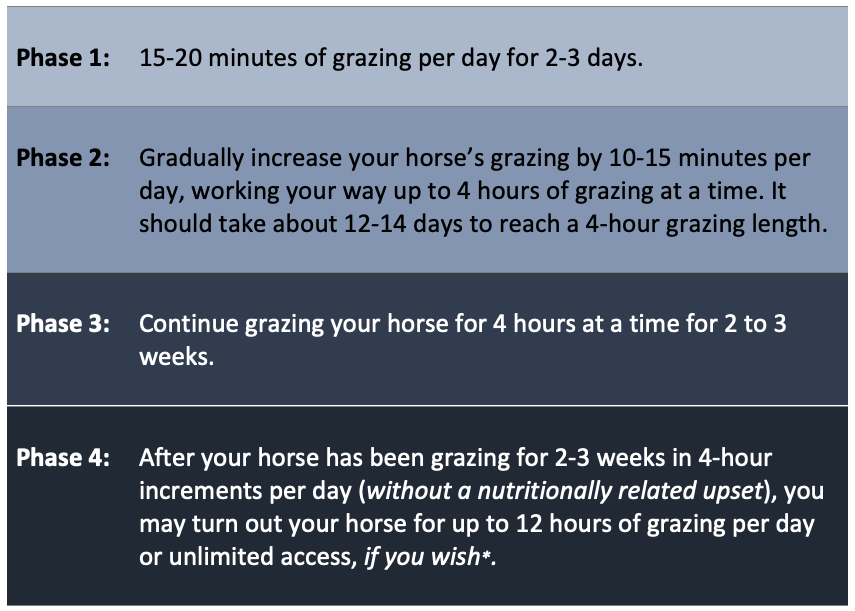
What about our more sensitive horses?
Sensitive horses require an even more robust gradual approach to grazing introduction. It might even mean that these horses should be grazing during the night time or early morning when the grass plants are not as metabolically active. The highest sugar levels will be found in the plant in the afternoon or early evening hours. Additionally, a grazing muzzle can be beneficial for limiting pasture intake for at-risk horses, such as when your schedule does not always allow for this very structured grazing regime.
Conclusions
The arrival of spring is a wonderful time, but it can also create some serious risk for horses. Being prepared with a plan for your horse is key to ensuring a smooth transition from hay to grass this spring. Continue to monitor your horse’s body condition score this spring to fine tune their diet. When in doubt, it is always safer to be cautious when making any dietary changes, especially when introducing horses back onto a grass pasture.
As each horse is unique, we always recommend talking with your regular veterinarian or a qualified equine nutritionist before making any changes to your horse’s diet. The next time your veterinarian is out, ask them about your horse’s nutritional needs. You should also schedule a visit from them in the early spring for a routine health check, dental evaluation and they can also assist you in determining your horse’s body condition score. Happy grazing! Spring will be here in no time.
Written by: T. Connor McCorkell


